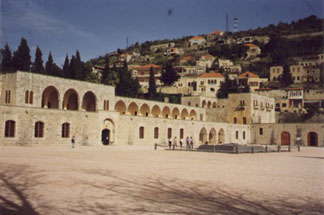Beit Eddine
Profile Altitude:
900m
Distance from Beirut: 44km
Getting
There
Take Saidon Road as far as Nahr el-Damour, Damour, continue to Kfarhim, to Deir
el-Qamar, and finally to Beit Eddine. |

|
Beit Eddine
Means "house of faith". Beiteddine is a palace built at the beginning of the
19th century, by Emir Bechir
Chehab II,
on a rocky spur dominating a steep, precipitous valley. A perfect example of
classic Lebanese architecture of the time, it has decorated ceilings, colorful
marble mosaic floors, luxurious Turkish Baths and harem suites, in a setting of
beautifully groomed gardens, a guest house in which the French Poet "Lamartine"
once dwelt, water jets and colonnades.
The palace
remained the emir’s residence until his forced exile in 1840, when the Ottomans
used it as the government residence. It was declared a historic monument in
1934, and then began a restoration process. Since 1943, it has been the summer
home of the president.
A folkroric museum occupies one wing and in the palace's renovated stables is an
exquisite display of mosaics from a ruined Byzantine church and other structures
of the same period.
Mir Amine Palace
Just minutes from Beiteddine is a restored palace of the same period that is now
one of the most beautiful hotels in Lebanon. Make a quick detour to see the
hotel, not forgetting to check out the bottom of the swimming pool which is
tiled to look like a Persian carpet. The view from the hotel is breathtaking.
 |
|
Dar El Baraniyyeh,
The outer section of the Palace.
On the approach to the palace a large parking area offers some of the best
views of the buildings and grounds. The main entrance leads to a 107x45 meter
courtyard, Al-Midan, where horsemen, courtiers and visitors used to meet for
various gatherings. From here, too, the Emir would leave with his retinue in
solemn procession, either for war or for the hunt. On the ground floor is a
museum, inaugurated on May 1, 1991. Through photographs, documents and
manuscripts, it tells the life story of Kamal Jumblatt, member of Parliament,
cabinet minister and Druze leader.
|
Beit Eddine History
In the Middle Ages
Lebanon was divided up into fiefs governed by emirs or hereditary sheikhs. But
in the early years of the 17th century, Emir Fakhr Ed Dine II Maan (d. 1635)
succeeded in extending his power throughout these princedoms and eventually
ruled an area corresponding to present-day Lebanon.
His first capital was at Baaqline but because of a chronic water shortage, he
was forced to move to Deir El Qamar where there were copious springs.
When the Maan dynasty died out at the end of the 17th century, the land was
inherited by the emirs of the Chehab family. It was Emir Bechir Chehab II who
decided to leave Deir El Qamar and to construct his own palace at Beiteddine
(House of faith), a druze hermitage which today is part of the palace.
In 1812, Emir Bechir
obliged each of his able-bodied males subjects to provide two days of unpaid
labor in order to ensure a plentiful supply of water at his new seat of
government. Within two years the project was completed.
The palace remained the emir's residence until his forced exile in 1840. After
the Ottomans suppressed the emirate in 1842 the building was used by the Ottoman
authorities as the government residence. Later, under the French Mandate
following World War I, it was used for local administrative purposes.
The General Directorate of Antiquities carefully restored Beiteddine to its
original grandeur after it was declared a historic monument in 1934. Beginning
in 1943, the year of Lebanon's independence, the palace became the summer
residence of the president. Bechara El Khoury was the first president to use
Beiteddine and he brought back the remains of Emir Bechir from Istanbul, where
he had died in 1850.
Today Beiteddine, with its museums and its gardens, is one of Lebanon's major
tourist attractions. Qualified guides are available for your tour through this
monument, which is open daily. A visit to Beiteddine is ideally combined with
nearby Dei Al Qamar.
Palace of Emir
Amine
A palace was built for each of the emir's three sons, Qassim, Khalil and Amine.
The palace of Emir Qassim, now in ruins, is perched on a promontory facing the
great Palace. Today Emir Khalil's palace is used as the Serail of Beiteddine,
the seat of local administration.
As for the palace of Emir Amine, which dominates the Beiteddine complex, it was
beautifully restored and converted into a luxury hotel by the Ministry of
Tourism.
Now called the Mir Amine Palace, most of the hotel's 24 rooms open onto private
terraces and a hanging garden.
Within walking
distance from Mir Amine Palace is the summer residence of the Maronite
Archbishop of Sidon, formerly Emir Bechir's country house. Some of the original
architectural elements remain, including a beautiful stone doorway covered with
a pagoda-shaped roof. This elegant doorway is reached by a high circular
staircase easily visible from a distance.
Information From the Ministry of
Tourism

|